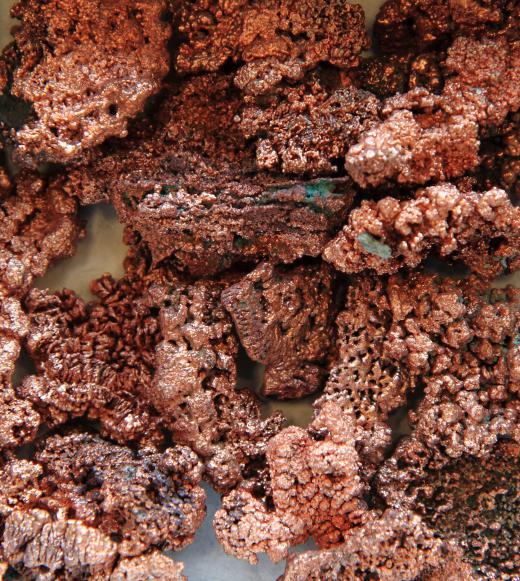At AboutMechanics, we're committed to delivering accurate, trustworthy information. Our expert-authored content is rigorously fact-checked and sourced from credible authorities. Discover how we uphold the highest standards in providing you with reliable knowledge.
What is Biomining?
Biomining is a method of extracting minerals and metals from their parent ores using naturally occurring biological processes. The practice requires none of the environmentally damaging processes found in conventional refinement methods and instead relies entirely on the natural interaction of biological organisms. The process has also proven to be effective at viably extracting minerals from low grade ore and tailings previously considered unusable. Biomining consists of two different refinement techniques: bioleaching or biooxidation. Although biological refinement of minerals shows great promise in the processing of a range of elements, the majority of biomining activity at present centers around the extraction of copper and gold.
Conventional mineral extraction methods rely on the application of toxic chemicals in the presence of extremely high temperatures; such processes often leave behind a legacy of environmental destruction, illness, and death. These factors have prompted the pursuit of cleaner and safer refinement methods more in line with the burgeoning global drive towards green solutions. Biomining has become one of the most promising of these involving nothing more than totally natural biological processes for is efficacy. These refinement methods need little intervention to initiate, produce no toxic byproducts or emissions, and require no external fuel sources. Represented by microbial leaching and oxidation processes, biological mineral extraction has many potential areas of application but is, at present, mainly utilized to process gold and copper.

The bioleaching process, one of the two refinement techniques, is a classic example of the simplicity of biomining methods. Low grade ore is dumped in a heap known as a leach pile and soaked with a weak sulfuric acid wash. The acid reaction with the ore's sulfide matrix encourages the growth of the bacterial strain Thiobaccilus ferrooxidans which degrades the ore and releases the metal or mineral deposits in a fluid solution. This mineral rich liquid is collected and separated and the residual sulfuric acid reused for the next leaching cycle.

The second biomining method, biooxidation, is widely used to prepare gold carrying refractory ore for extraction. This process involves exposing the ore to bacterial oxidation which breaks down the otherwise insoluble pyrite and arsenic components. This allows the ore to be processed utilizing far less aggressive methods with reduced environmental implications. This type of benefit has seen biomining grow apace as a viable alternative to mainstream mineral refinement with 25% of the world's present copper production being biomined. This trend is sure to continue as global pressure mounts for consumers and suppliers to become more environmentally responsible.
AS FEATURED ON:
AS FEATURED ON:












Discussion Comments
How can I find results for extracting metals using acid?
@everetra - I agree. While I think the use of biotechnology in mining has a part to play and does seem to be environmentally friendly, it is not without its problems.
Take the example of bioleaching in the article. The ore is exposed to sulfuric acid, the cesspool which grows the bacteria.
I’m not a chemist by I don’t know how environmentally friendly sulfuric acid is. So I think we need a more holistic view in these matters.
It will never be either/or in my opinion – either use traditional mining or biomining. We will always have to use the best of both worlds. Also, whatever technology is used, it will have to be justified on a cost basis; otherwise it won’t last.
It holds promise I think, but you first have to get the gold ore out of the ground. You need traditional mining techniques for that.
After you dig it up, then you can expose it to the bacterial oxidation process to allow the gold to be extracted easily. I think the term biomining is a little misleading.
Mining will always be a labor intensive process requiring lots of man hours to produce decent results. However, I do think that biomining, as a phase in the overall process, has a role to play and is very useful in the mining industry.
Post your comments